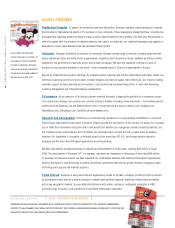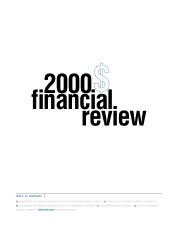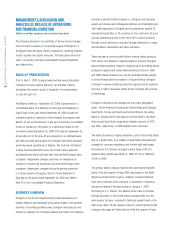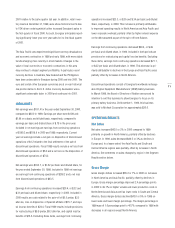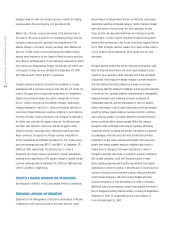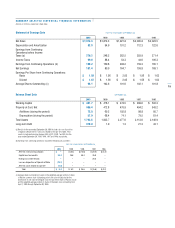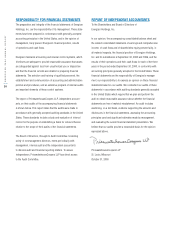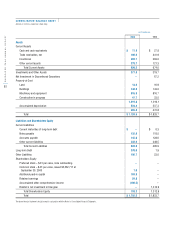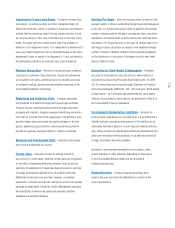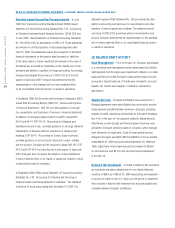Energizer 2000 Annual Report Download - page 20
Download and view the complete annual report
Please find page 20 of the 2000 Energizer annual report below. You can navigate through the pages in the report by either clicking on the pages listed below, or by using the keyword search tool below to find specific information within the annual report.
ENERGIZER 2000 ANNUAL REPORT
18
Energizer does not enter into foreign currency contracts for trading
purposes where the sole objective is to generate profits.
Market risk of foreign currency derivatives is the potential loss in
fair value of net currency positions for outstanding foreign currency
contracts at fiscal year end, resulting from a hypothetical 10%
adverse change in all foreign currency exchange rates. Market risk
does not include foreign currency derivatives that hedge existing
balance sheet exposures, as any losses on these contracts would be
fully offset by exchange gains on the underlying exposures for which
the contracts are designated as hedges. Accordingly, the market risk
of Energizer’s foreign currency derivatives at September 30, 2000
and 1999 amounts to $2.6 and $1.5, respectively.
Energizer generally views as long-term its investments in foreign
subsidiaries with a functional currency other than the U.S. dollar. As
a result, Energizer does not generally hedge these net investments.
Capital structuring techniques are used to manage the net invest-
ment in foreign currencies as considered necessary. Additionally,
Energizer attempts to limit its U.S. dollar net monetary liabilities in
currencies of hyperinflationary countries, primarily in Latin America.
In terms of foreign currency translation risk, Energizer is exposed to
the Swiss franc and other European currencies; the Mexican peso
and other Latin American currencies; and the Singapore dollar,
Chinese renminbi, Australian dollar, Indonesian rupiah and other
Asian currencies. Energizer’s net foreign currency investment in
foreign subsidiaries and affiliates translated into U.S. dollars using
year-end exchange rates was $515.1 and $545.1 at September 30,
2000 and 1999, respectively. The potential loss in value of
Energizer’s net foreign currency investment in foreign subsidiaries
resulting from a hypothetical 10% adverse change in quoted foreign
currency exchange rates at September 30, 2000 and 1999 amounts
to $51.5 and $54.5, respectively.
RECENTLY ISSUED ACCOUNTING STANDARDS
See discussion in Note 2 to the Consolidated Financial Statements.
FORWARD-LOOKING INFORMATION
Statements in the Management’s Discussion and Analysis of Results
of Operations and Financial Condition and other sections of this
Annual Report to Shareholders that are not historical, particularly
statements regarding anticipated category trends, Energizer market
share and sales in future periods, the future adequacy of cash
flows, and the risk associated with financial instruments and the
concentration of credit, may be considered forward-looking state-
ments within the meaning of the Private Securities Litigation Reform
Act of 1995. Energizer cautions readers not to place undue reliance
on any forward-looking statements, which speak only as of the
date made.
Energizer advises readers that various risks and uncertainties could
affect its financial performance and could cause Energizer’s actual
results for future periods to differ materially from those anticipated
or projected. Technological or design changes in portable electronic
and other devices that utilize batteries as a power source may
significantly affect the demand for batteries. Continuing improvements
in the service life of primary batteries, improvements in rechargeable
battery performance and increasing consumer acceptance of
rechargeable batteries, and the development of new non-alkaline
battery technologies could all significantly affect continued category
growth for primary alkaline batteries. General economic conditions
and continuing growth in consumer demand for portable electronic
devices could also affect category growth. Within the category,
Energizer’s sales and market share may be negatively affected by
competitive activity, including new product introductions or advertis-
ing campaigns, retail discounts and other promotional activities.
Competition for key retail customers and growth of the lower-price
private-label battery segment may also negatively affect sales or
market share for Energizer. Unforeseen fluctuations in levels of
Energizer’s operating cash flows, or inability to maintain compliance
with its debt covenants, could limit Energizer’s ability to meet
future operating expenses and liquidity requirements, fund capital
expenditures or service its debt as it becomes due. Economic turmoil,
currency fluctuations and unforeseen customer financial difficulties
could increase Energizer’s risk from currency hedges and other
financial instruments or from the extension of credit to customers.
Additional risks and uncertainties include those detailed from time to
time in Energizer’s publicly filed documents, including its Registration
Statement on Form 10, as amended, and its Current Report on
Form 8-K dated April 25, 2000.


